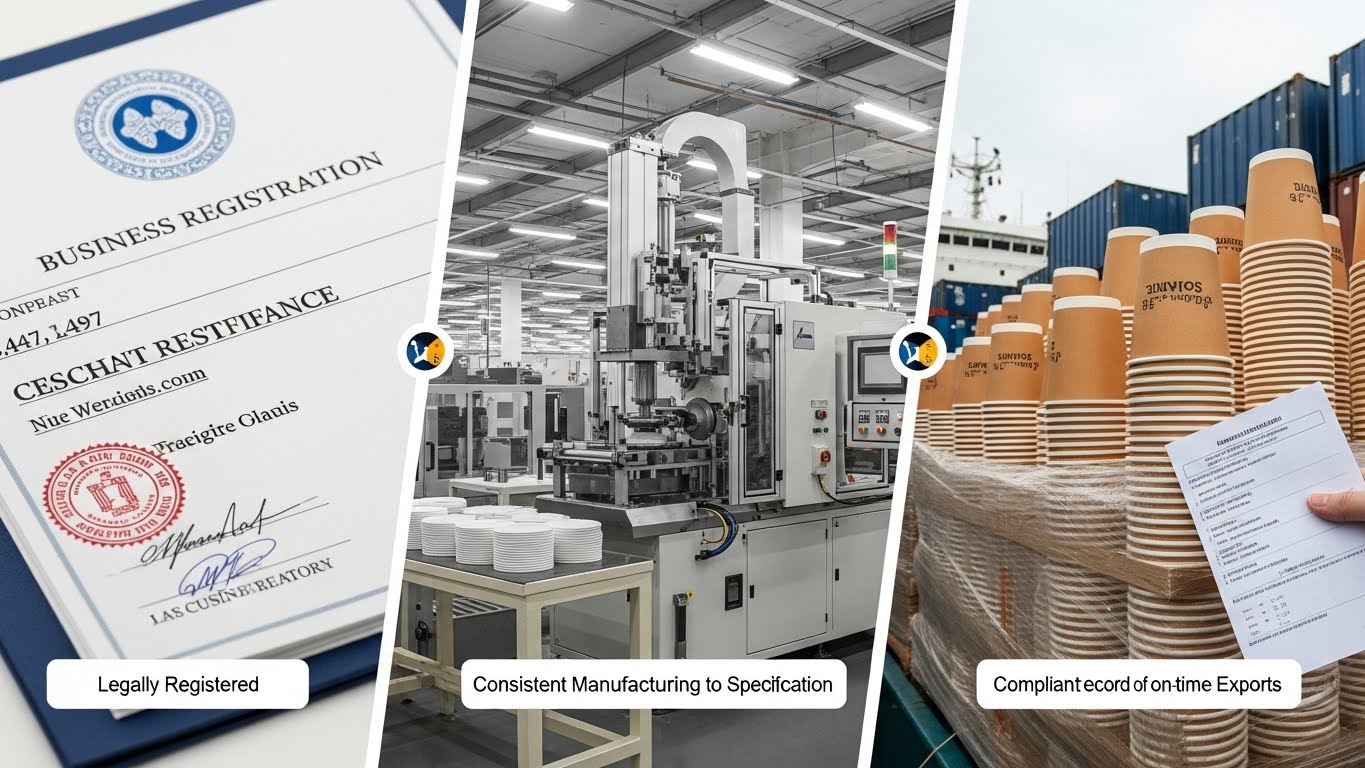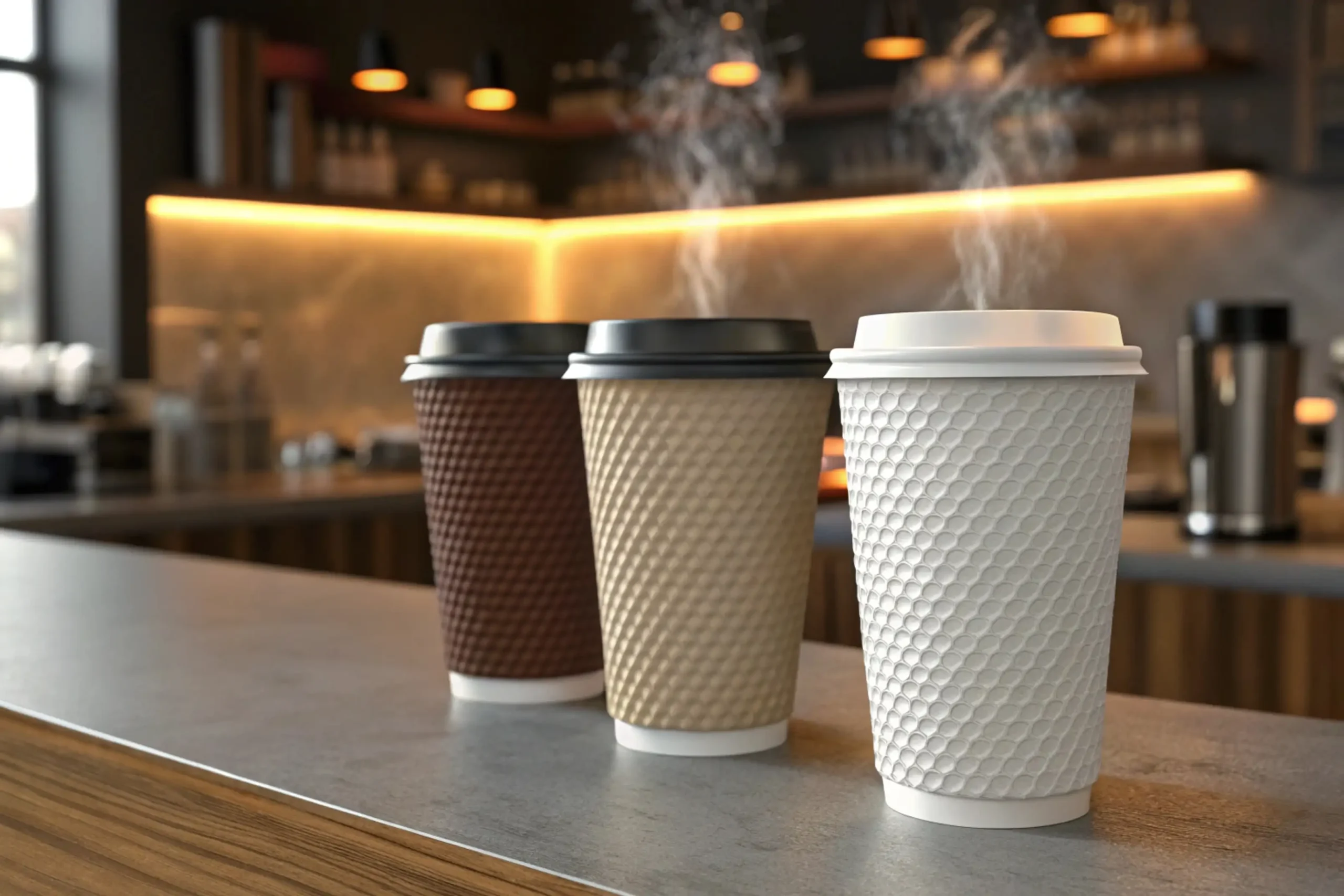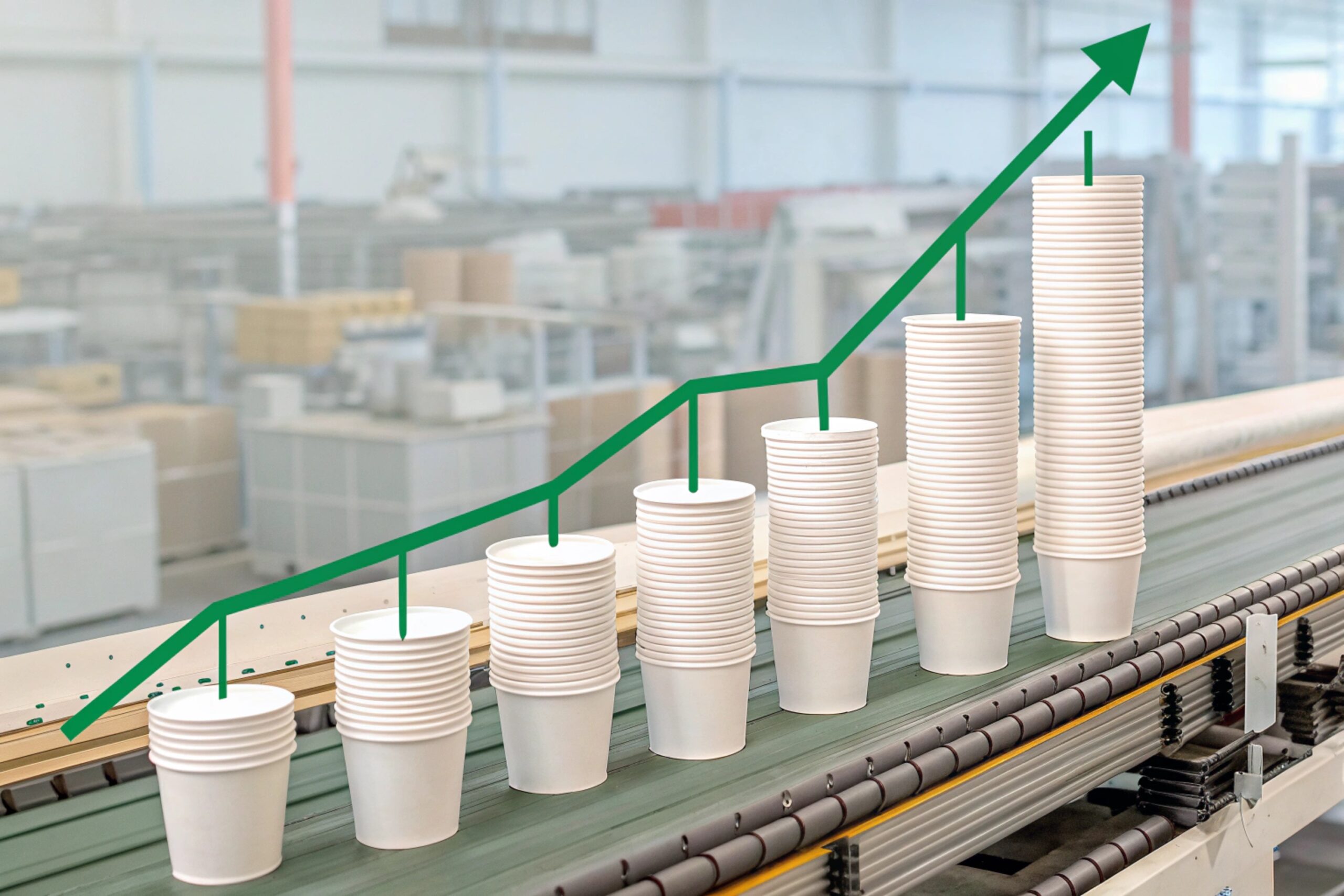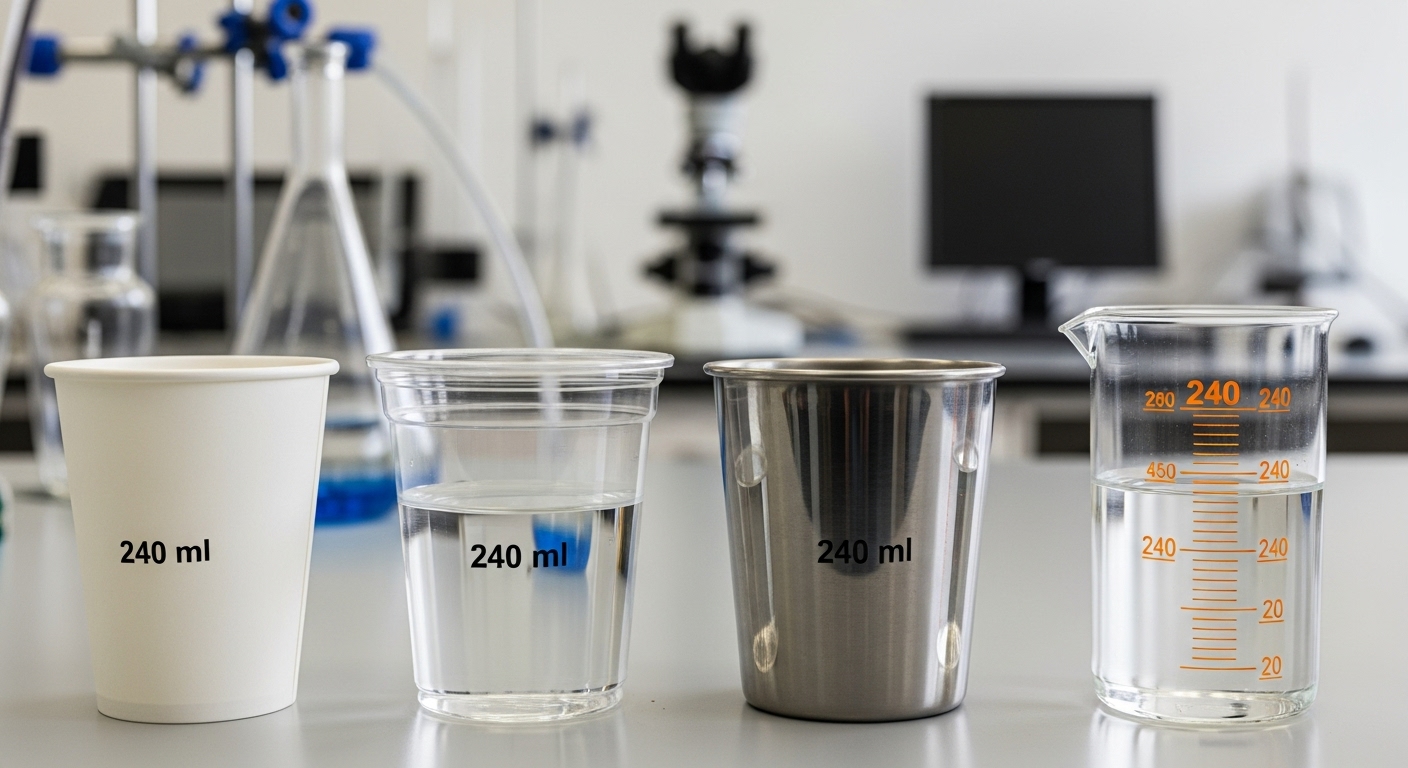As a business owner or procurement manager in the food and beverage industry, understanding the raw materials used in paper cup production is crucial.
Whether you’re just starting or already running a production line, making informed decisions about the materials you use can significantly impact both cost and product quality.
Whether you are a new buyer, a manufacturer with existing machines, or a seasoned buyer with suppliers, understanding the raw materials used in paper cup production is essential. This guide helps you choose the best materials, optimize your supply chain, and ensure cost-effectiveness.For businesses in the paper cup industry, sourcing high-quality materials like PE coated paper, paper cup blanks, and cupstock paper is crucial for production efficiency. This guide offers practical insights on managing costs and supplier relationships.
This guide will take you through the different raw materials used in paper cup manufacturing, covering everything from cupstock paper to PE-coated paper, and help you choose the right options for your business.
Three Buyer Scenarios in the Paper Cup Industry
2.1 New Buyers: Understanding Raw Materials and Costs
When you’re new to the paper cup industry, it’s vital to understand the raw materials involved in production.
Paper cups are typically made from cupstock paper, which is either uncoated or PE-coated for moisture resistance. For buyers just entering the market, understanding these materials and their costs is the first step.
Cupstock paper 【Download Technical Data Sheet】 is the foundation for every paper cup. It’s typically a strong, high-quality paperboard. In most cases, PE-coated cupstock paper is preferred because of its ability to withstand liquids and heat. For smaller cups, like a raw paper cup 4 oz, uncoated options may be suitable for dry contents.
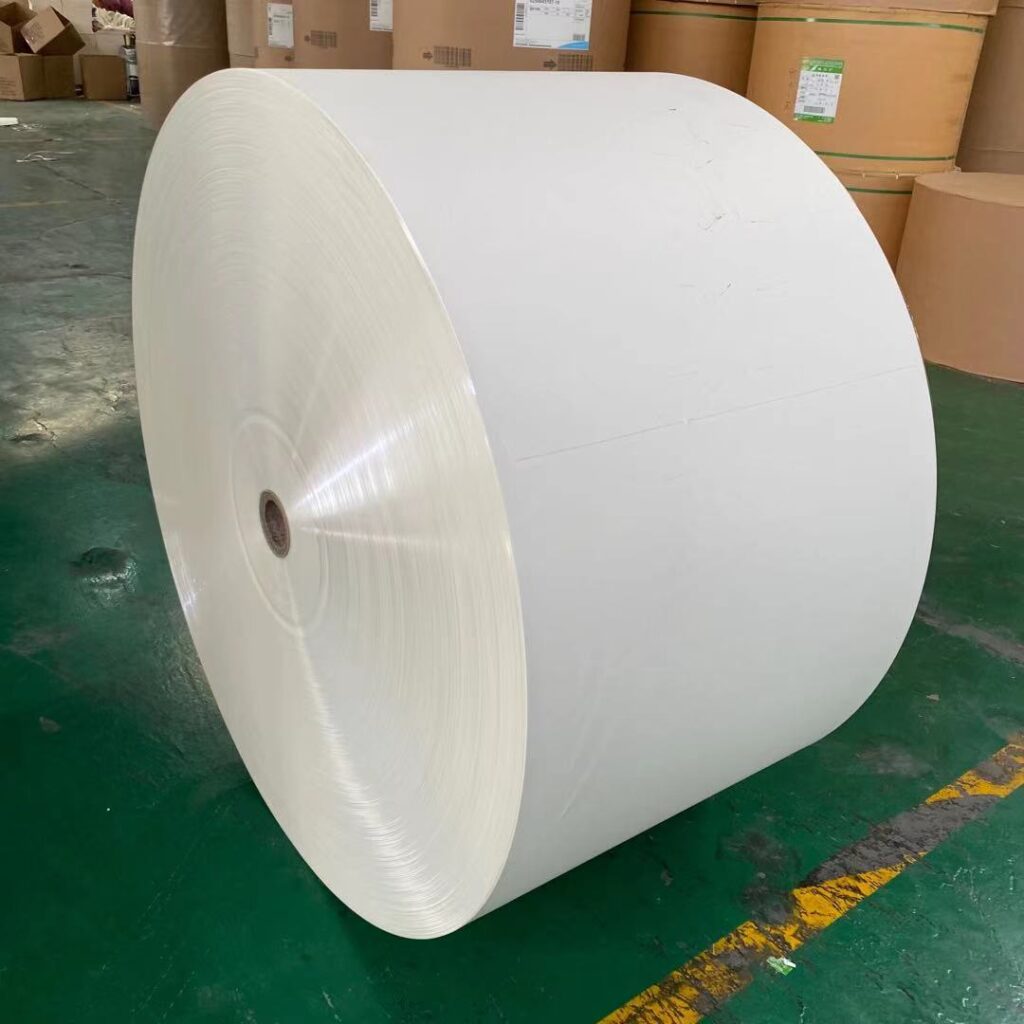
However, for beverage cups, especially those used for hot drinks or liquid-filled products, a PE-coated paper cup or PE-coated cup stock paper is essential to prevent leakage and provide the necessary moisture resistance.
Cost considerations are paramount. The price of cup stock paper will vary depending on the type of coating, the grade of paper used, and the volume purchased.
Latest Quotation Price list in August 2025 for your reference here:
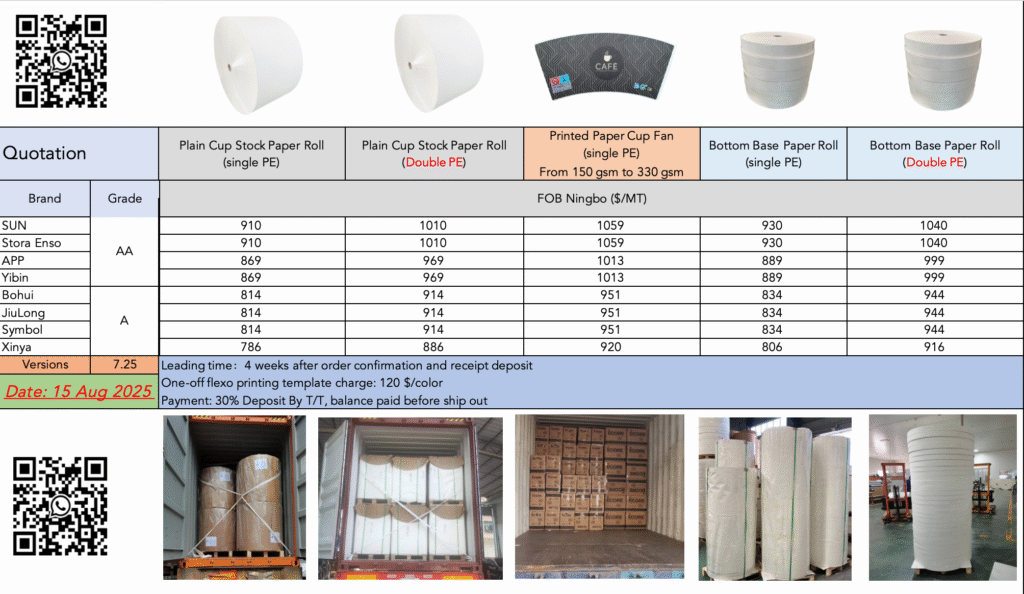
As a new buyer, it’s crucial to balance initial costs with long-term benefits. Here’s a quick breakdown of cost factors for your raw materials:
Table 1: Cost Breakdown of Raw Paper Cup Production
| Material | Price per Ton (Approx.) | Applications |
|---|---|---|
| Uncoated Cupstock Paper | $650–$750 | Dry foods, snack containers |
| PE Coated Cupstock Paper | $800–$900 | Brown kraft cups, eco-friendly Kraft bowl or container |
| PE Coated Kraft Paper | $900–$1,000 | Brown Kraft cups, eco-friendly Kraft bowl or container |
2.2 Manufacturers with Machines: Looking for Semi-Finished Blanks
If you already have paper cup forming machines, your next step is sourcing semi-finished products like paper cup blanks or paper cup fans.
These products are pre-cut and pre-printed, ready to be rolled into cups by your machines. For businesses that already own paper cup manufacturing machines, buying pre-cut paper cup blanks makes the production process more efficient and cost-effective.

Paper cup blanks are simply sheets of paper that have been pre-cut and often pre-printed, ready for shaping into cups.
In contrast, paper cup fans are slightly more advanced, shaped in a way that allows them to be quickly and easily rolled into a finished cup. These pre-made components can save manufacturers significant time and reduce waste.
When it comes to paper cup blank price, there’s an advantage to buying pre-made blanks and fans. Not only do you save on the initial investment for paper cup blank cutting machines and paper cup blank printing machines, but you also avoid the risk of errors that might occur with in-house printing and cutting.
Table 2: Raw Materials vs. Semi-Finished Products
| Product Type | Key Features | Buyer Advantage |
|---|---|---|
| Raw Paper Rolls | Unprocessed, requires in-house cutting and printing | Lower upfront cost, flexible design |
| Paper Cup Blanks | Pre-cut, pre-printed sheets | Save time, guaranteed quality |
| Paper Cup Fans | Pre-die-cut fan-shaped sheets | Effortless shaping, consistent branding |
2.3 Buyers with Existing Suppliers: Optimizing the Supply Chain
For those who already have cupstock paper suppliers, the focus shifts to optimizing the supply chain. The main concerns for these buyers are finding reliable suppliers who can consistently deliver high-quality materials at competitive prices. Evaluating PE coated paper suppliers and cupstock paper board suppliers based on their lead times, pricing, and consistency can make a significant difference in the long run.
When working with paper cup blanks suppliers, it’s essential to regularly review the paper cup blank price and ensure it aligns with the market. Buyers may also look for PE coated paper sheet options, which come in various grades, thicknesses, and coatings. Opting for a supplier who can provide both uncoated cupstock paper and PE-coated paper can streamline purchasing processes and ensure flexibility in production.
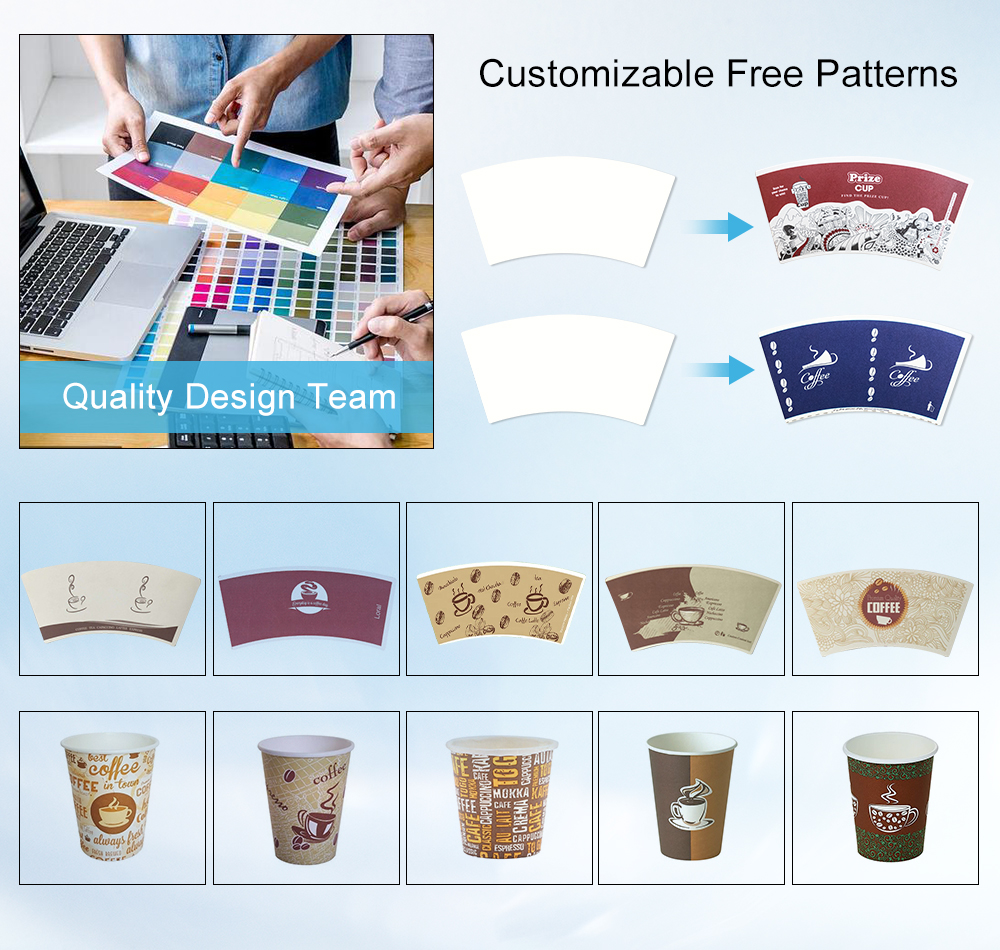
Supplier negotiation tips include setting clear expectations for material quality, price, and lead times, and establishing long-term contracts that benefit both parties. Regular communication and proactive management of supplier relationships can also help mitigate risks associated with price fluctuations and supply chain disruptions.
Table 3: Supplier Evaluation Matrix
| Supplier Criteria | Importance | Key Considerations |
|---|---|---|
| Quality Consistency | High | Ensure food-grade compliance, certified materials |
| Lead Time | High | Ensure timely delivery, especially for large orders |
| Price Stability | Medium | Negotiate long-term contracts to lock in pricing |
| Flexibility | Medium | Ability to handle small and large orders efficiently |
3. Raw Material Knowledge Hub
3.1 Cupstock Paper Basics
Cupstock paper is the primary material used to produce paper cups. It comes in various types, with the most common being cupstock paper board and cup stock paper. Manufacturers typically offer different grades of cup stock paper, depending on the required strength and durability for the final product. Cupstock paper suppliers play a significant role in providing consistent, high-quality materials that ensure the performance of the final product.
There are two main types of cupstock paper:
- Uncoated cupstock paper – Eco-friendly and biodegradable, but not moisture resistant. Ideal for dry products.
- PE-coated cup stock paper – Provides liquid resistance, essential for beverage cups.
Cupstock paper manufacturers supply various grades, each suited to specific applications like cold or hot drinks. The PE coated paper options are often the preferred choice for most beverage cups, especially those used for hot beverages like coffee or tea.
3.2 PE Coated Paper and Alternatives
PE-coated paper is the most commonly used material for paper cups. It provides an excellent barrier against liquids and moisture, which is essential for holding hot or cold beverages.
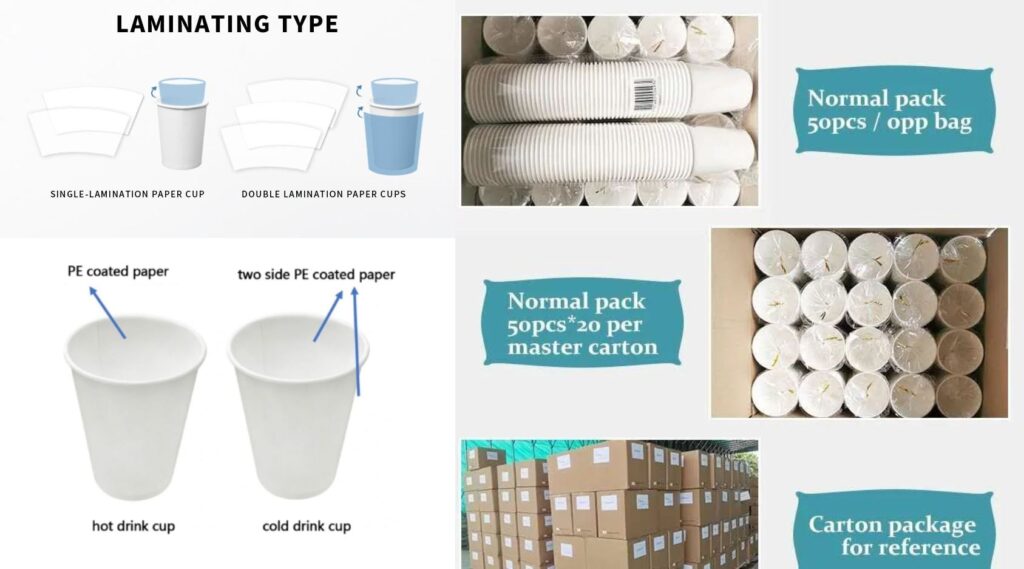
Polyethylene-coated paper or PE coated paper for paper cup is especially effective for keeping liquids in and maintaining the structural integrity of the cup. There are various options for coating thickness and types:
- One side PE coated paper – More cost-effective for basic applications.
- Double side PE coated paper – Provides enhanced durability and is used for more demanding applications.
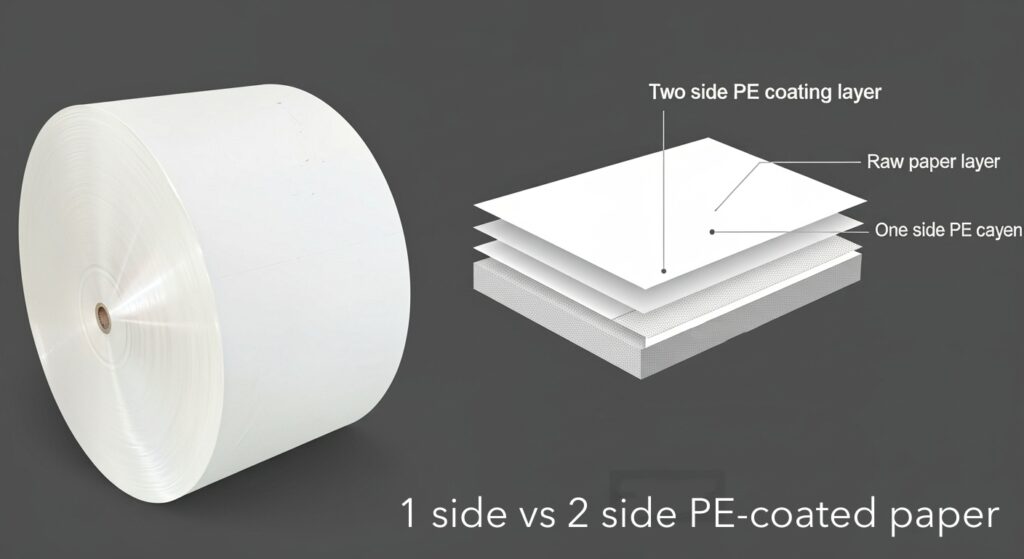
For eco-conscious businesses, PE laminated paper options are a good alternative, though slightly more expensive than standard PE coated kraft paper.
3.3 Semi-Finished Products for Flexibility
As mentioned, paper cup blanks are pre-printed, pre-die-cut sheets ready for forming. They come in various sizes, and are often made from cupstock paper with PE coating. Choosing paper cup blanks suppliers who can provide consistent quality is key for businesses aiming for long-term production stability. These semi-finished products allow manufacturers to focus more on the forming process, reducing the need for expensive printing and cutting equipment.
4. Solutions and Strategic Recommendations
4.1 For New Buyers
For businesses that are just entering the paper cup industry, the best strategy is to start by understanding the core raw materials involved. Consider purchasing raw paper cup 4 oz or tea cup raw material samples before making large investments. Small, flexible orders help you gauge product quality and machine compatibility before scaling up.
But how many pieces of cups you can producing in 1 ton paper fan? see chart below:

When it comes to cost management, understanding the breakdown between cup stock paper price and PE coated paper price will allow you to compare options effectively. As you grow your business, opt for PE-coated cup stock paper for your beverage cups, ensuring they are reliable and safe for consumers.
The cost-benefit analysis for new buyers should factor in not just material costs, but also the flexibility in sourcing. A strong relationship with paper cup blank manufacturers ensures that you have access to quality materials at a fair price, while also helping you scale as your business grows.
4.2 For Manufacturers with Machines
For businesses that already own paper cup forming machines, the next step is to optimize the production process by sourcing semi-finished products such as paper cup blanks or paper cup fans. These products are designed to fit your existing machines and reduce downtime during production.
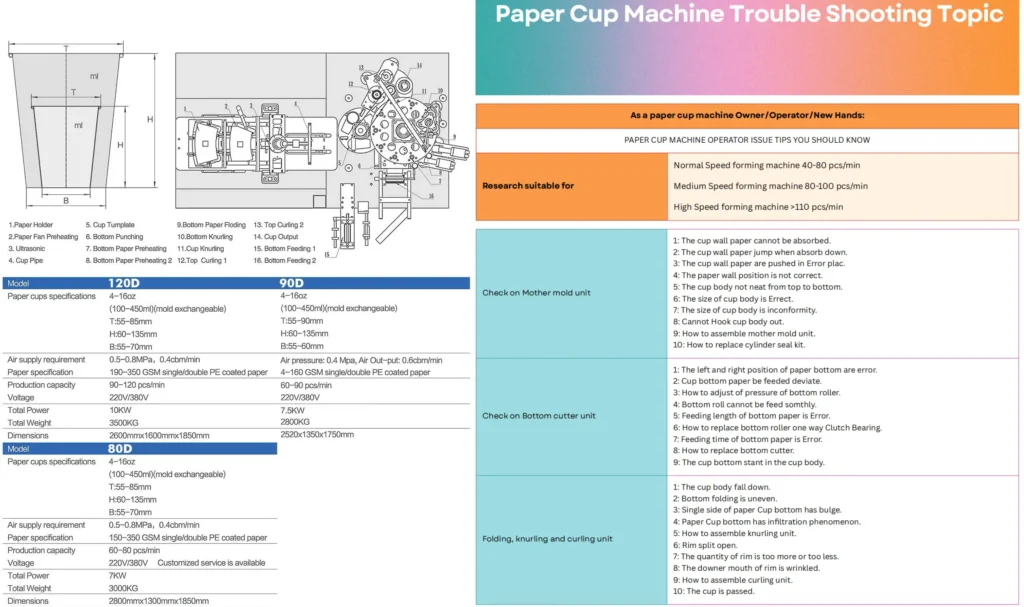
By outsourcing printing and die-cutting, you avoid the investment in expensive paper cup blank cutting machines and paper cup blank printing machines. Instead, you can focus your investment on ensuring the highest quality PE coated paper and cupstock for production. This enables you to cut operational costs while maintaining consistency in your products.
See video about: No More Broken Cups when production: How to Perfect Water Spraying on paper cup fans.
For manufacturers looking to expand their production capacity, consider sourcing PE coated paper for paper cup from trusted paper cup blanks suppliers who can meet your needs for high-volume production. It’s essential to have a reliablehttps://onlinelibrary.wiley.com/doi/abs/10.1002/pts.932 partner who can provide consistent material quality while meeting your volume demands.
4.3 For Buyers with Suppliers
For businesses that already have existing suppliers, the focus should shift to optimizing supplier relationships. This is where comparing prices, evaluating lead times, and ensuring material consistency becomes crucial.
Buyers with established suppliers should regularly review their PE coated paper suppliers and cupstock paper suppliers to ensure that they are still getting the best deal in terms of both cost and quality.
You can optimize your procurement process by consolidating your supply chain. Rather than purchasing PE coated paper from multiple suppliers, work with a single partner who can provide paper cup blank raw material, PE laminated paper, and paper cup blanks. This reduces administrative overhead and ensures a streamlined purchasing experience.

Consider long-term contracts with paper cup blanks suppliers to lock in favorable prices and guarantee supply, reducing the risk of price volatility. Be proactive about managing your supplier relationships, especially with PE coated paper manufacturers, to avoid disruptions and improve cost predictability.
Table 4: Supplier Relationship Optimization
| Strategy | Key Benefit | Considerations |
|---|---|---|
| Consolidate Suppliers | Reduces administrative costs | Ensure one supplier can meet all needs |
| Long-Term Contracts | Price stability, supply security | Negotiate early for discounts |
| Performance Reviews | Ensure quality consistency | Regularly assess quality metrics |
5. Conclusion and Call to Action
5.1 Recap: A Tailored Approach for Every Buyer
In this guide, we’ve covered the key raw materials used in paper cup production, including cupstock paper, PE coated paper, and paper cup blanks. Each type of buyer—whether you’re new to the industry, already operating machines, or working with established suppliers—has different needs and strategies for sourcing the right materials.
- New buyers should focus on understanding raw materials and costs, starting with smaller orders for better flexibility.
- Manufacturers with machines benefit from sourcing semi-finished products like paper cup blanks and fans to reduce production time.
- Buyers with suppliers can optimize their supply chain by consolidating purchases and negotiating long-term contracts.
5.2 Call to Action
If you are in the paper cup industry and seeking a trusted partner for cupstock paper, PE coated paper, or paper cup blanks suppliers, we are here to help. We specialize in providing high-quality, reliable raw materials, including PE coated paper for paper cups, cupstock paper board, and PE laminated paper. Our extensive supplier network ensures competitive pricing, consistent quality, and flexible lead times.
Contact us today to discuss how we can meet your specific needs. Whether you’re looking for raw paper cup 4 oz or tea cup raw material, we offer tailored solutions to help your business grow efficiently. Let us help streamline your production process and reduce costs.
FAQ
1. What are paper cup raw materials made of?
Paper cup raw materials are mainly cupstock paper, either uncoated or PE-coated for liquid resistance. The base material is then cut into blanks or fans for cup forming. The material choice impacts cup durability and cost.
2. What is the price of paper cup stock?
Cupstock paper price varies depending on the type (uncoated or PE-coated), grade, and order volume. For example, PE-coated cupstock paper generally ranges between $750–$950 per ton based on quality and market conditions.
3. What is a paper cup blank and how is it used?
A paper cup blank is a pre-cut sheet of paper, often pre-printed, that forms the body of the cup when rolled. It is used by manufacturers to streamline production, reducing time spent on cutting and printing.
4. What is the difference between paper cup blanks and paper cup fans?
Paper cup blanks are flat sheets of cupstock paper that require in-house cutting and forming, while paper cup fans are pre-die-cut and pre-printed sheets that are ready for quick forming into cups, saving time and ensuring consistent quality.
5. What are PE-coated paper options for paper cups?
PE-coated paper provides a moisture-resistant barrier for paper cups. It comes in different forms such as one side PE-coated paper and double side PE-coated paper, which provide different levels of durability, suitable for both hot and cold beverages.
6. How do I choose the best supplier for paper cup raw materials?
When selecting a paper cup blanks supplier or PE-coated paper manufacturer, consider quality consistency, pricing stability, lead times, and compliance with food safety standards. Long-term contracts and transparent relationships with suppliers help secure the best deals.
7. What machines are needed for paper cup production?
To produce paper cup blanks and fans, you need machines such as paper cup blank making machines, printing machines, and cutting/punching machines. These machines allow you to efficiently produce semi-finished products that can be quickly formed into cups.


